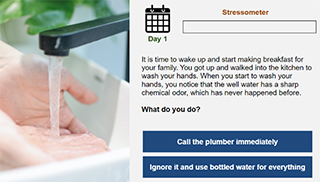June 1, 2023

When residents discover or suspect pollution is harming their community, the process of investigating and fixing the problem can be overwhelming. Drawing on decades of experience working with communities dealing with contamination, members of three NIEHS-funded research centers developed an online resource to guide residents through the daunting environmental cleanup process.
“Hazardous waste cleanup can be contentious – information gradients and poor communication among stakeholders contribute to delays, confusion, and mistrust,” said Susan Pinney, Ph.D., Director of the Environmental Health Sciences (EHS) Core Center at the University of Cincinnati. “There are few educational resources for community organizations, governmental agencies, and commercial entities to use to improve multi-directional communication while addressing an environmental hazard and navigating the cleanup process.”
To fill this gap, Pinney worked with Marilyn Howarth, M.D., of the University of Pennsylvania EHS Core Center, and Kathleen Vandiver, Ph.D., of the Massachusetts Institute of Technology Superfund Research Program Center, as well as community groups, to create a resource to guide communities through environmental cleanup activities. The resource includes three educational modules, including lessons learned to help communities address contamination.
A History of Contamination

The first module provides background information on three communities dealing with contamination: Ambler, Pennsylvania; Wilmington, Massachusetts; and Fernald, Ohio. According to Pinney, contamination and poor waste management practices at each of these sites led to significant exposure to community members.
Ambler was the site of the largest manufacturer of asbestos products, resulting in community exposures and an increase in asbestos-related diseases, such as lung cancer and mesothelioma.
A plastic and rubber production center in Wilmington contaminated a nearby aquifer and wells with cancer-causing nitrosamines (NDMA). Researchers later confirmed a positive association between prenatal NDMA exposure and childhood cancer.
Fernald was home to a uranium refinery which released airborne uranium particulates and contaminated the community’s air and water.
Development of the Tool

Community partners were key in the process of building the tool. Development began in Fernald, where residents initially created a printed resource to tell their story of environmental cleanup and document lessons learned.
“Fernald was trying to get funds to expand and polish the document, and they were frustrated,” said Pinney. “I talked to NIEHS about the possibility of using center community engagement funds and they suggested including other sites to reach a broader audience.”

To expand the tool and share other stories, the Fernald team partnered with researchers and community groups addressing contamination in Ambler and Wilmington. As the resource grew, the team decided to incorporate video footage – including life history interviews from residents – and to make the modules interactive.
For example, the modules include videos on topics such as how to form a community organization and build respectful relationships, best practices for organizing and hosting meetings, and tips for developing a comprehensive public involvement program.
Interactive exercises take the viewer through various scenarios, including addressing well water contamination, taking action with neighbors, and handling public relations issues. The viewer can click on a possible response to these scenarios, guiding them through a decision-making process.
Lessons Learned and Next Steps
The resource offers 17 lessons learned during the process of environmental cleanup. To identify these lessons, the researchers and community partners focused on commonalities, rather than unique circumstances, of the environmental cleanup process in their communities. Some of those lessons are to:
- Involve community members, regulators, elected officials, and others from the beginning.
- Set expectations that it will take a long time to fix the contamination problem.
- Work towards agreement on big concepts.
Moving forward, the team will develop an online workbook to complement the modules. They will also add more discussion questions and role-playing exercises to the resource.
“I hope the resource will help communities dealing with environmental exposures by encouraging them to develop a good, robust plan on how they are going to tackle this problem,” Pinney said.


